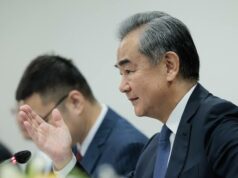By Yashovardhan Sinha
Pakistan & China are the two countries with whom we have gone to war and with whom we continue to be daggers drawn. Therefore The China Pakistan Axis: Asia’s New Geopolitics attracted me by its very name. Andrew Small is an American Oxonian who specialises in China studies and has written a balanced and educative book.
While the trajectory of Indo-Pak relations are fairly well known, we are not as familiar when it comes to China. I was surprised to learn that in the early years after Mao’s victory it was India that supported Beijing over Taipei’s claim to the Chinese seat in the UN. After the Chinese invasion of Tibet in 1950 India helped defeat Tibetan appeals at the UN.
Unfortunately, since the author’s focus is elsewhere he doesn’t really explain the U-turn in India’s approach from opposing Tibetan appeals to welcoming the Dalai Lama in 1959.
Although the book is about the China- Pakistan axis, it is as much about India which to a great extent keeps the axis in place.
China’s hostility towards India stems from (1) the former’s expansionist history when it has throughout its history laid claims to lands belonging to neighbours, (2) sense of competitiveness with a democratic country which for a while at least seemed to be running a keen race with it, and (3) the U-turn referred to above.
Conveniently for China, Pakistan provides a proxy for pursuing its anti-India approach. Aware of the difference in military might Pakistan has always relied upon irregular forces to wage conflict and inflict damage on its neighbour.
Right after independence it had used non-state actors (Pashtun tribal militia) when it invaded Kashmir. This approach continued in 1965 and 1971 and China collaborated directly with the Pakistanis.
This period also saw the growth of ISI (Inter Services Intelligence) from an inconsequential outfit to a well-funded, autonomous organization which often seems to wag the dog by consolidating control over the Kashmir militant groups and the groups working in Afghanistan.
The Chinese, as expected, have close links with the ISI. China in fact did not confine itself to helping Pakistan in its designs on Kashmir.
In the 1960s and 1970s Beijing actively armed and trained insurgents amongst Nagas, Mizos, Manipuri and other disgruntled elements in our North-East.
And this nefarious activity has continued. In 2004 a huge cache of Chinese weapons headed for rebels in Nagaland and Assam was caught in Bangladesh.
But the area where the China-Pakistan axis has been most blatant and pernicious has been nuclear support. It’s been a two-way street, in some ways.
The infamous AQ Khan, who stole designs from western laborotories where he worked or visited, is reported to have shared them with other players like China and even North Korea.
In exchange for cash and stolen uranium enrichment designs and components, North Korea provided Pakistan with nuclear missiles. The Chinese provided them with rocket-launcher designs for their nuclear weapons.
After Pokharan 2, Chinese support to the Pakistanis became more open and wide-ranging, in total disregard to its own commitments at the time of joining the NSG.
The members of the NSG knew that China was violating agreements but had little appetite for a showdown. In fact many blamed the USA for its nuclear deal with India. So what India had achieved from the USA in 2008 by making a list of commitments in line with international norms, China provided to Pakistan with no matching commitments from Islamabad.
While the origins of the axis that China had formed with Pakistan can be seen in its antagonism to India and its desire to cosy up with the USA (via America’s ally in the neighbourhood, Pakistan) as its relationship with the USSR soured, more substantial grounds emerged with time.
The Americans had used the Taliban to push the Russians out of Afghanistan, and then got stuck in the mess that followed. As the Americans began trying to wriggle out of the mess, the Chinese saw an opportunity to play a more dominant role in its western neighbourhood.
To the Chinese the western part of their country and their western neighbourhood together appeared as a part of a new westward policy. And thus began talk of the revival of the old Silk Road.
Western China had always been neglected economically and it was acknowledged that it had the highest growth potential.
Politically it was felt that stabilization and economic development not only of Xinjiang and countries surrounding it was the best way to tackle the growing menace of separatism of the Uyghurs and related terrorist threats.
Contrasted to the direct confrontation that the Chinese were facing in their attempts to extend their hegemony in the east (East and South China Seas), especially from the Americans, they had an open field in the west and soon became active in areas like energy, transportation, infrastructure and trying to promote regional stability.
And Pakistan had a vital role to play in this. It was one of China’s oldest and constant friend. It was a major market in its own rights and its location could make it China’s gateway to the gulf.
Its economy was weak and it would gratefully join any plan that the Chinese put up that promised employment opportunities and building up of infrastructure.
Therefore, when President Xi Jinping rolled out his ambitious BRI, the China Pakistan Economic Corridor was its major plank. The Initiative and Corridor are subject to a lot of conflicting views and calls for separate discussion. But as things stand, the CPEC is still on the table and both China and Pakistan are swearing by it.
But how strong is the China- Pakistan axis itself? Is it really as strong as is being made out by Beijing and Islamabad? To anwer this, we need to examine a little more closely what’s happening in Pakistan.
Way back in the 1980s, President Zia began the process of Islamization of the Pakistani Army.
He did this by by-passing the traditional military families and finding new recruits from lower middle class families – candidates who were more prone to influence by the Jamaat-e-Islami and other religious organizations. The impact has begun to show and the Chinese are not blind to it. At one time the Uyghurs had a major base in Pakistan.
The Uyghurs do not carry much weight in the wider Muslim world. “East Turkistan” does not even feature in some of the maps of the so-called Caliphate. But, despite Chinese pressure, there are still some Uyghur militants in western Pakistan whom the Pakistanis seem to be unable to flush out.
This, the Chinese believe, is because of their sympathisers in the Pak army. And this sympathy for the Uyghurs is symptomatic of a wider Islamization of the military.
Concern is being expressed in China that it was one thing to provide comprehensive military assistance to an India-centric Pak Army and quite a different thing to provide support when elements in that army have started believing in Jihad.
A Chinese expert is reported to have said, “We are not worried about the generals, we’re worried about the brigadiers.” In fact there is growing concern – and not just in China- over the growing Talibanization of Pakistan itself.
The dominant view for long in China was to look upon the problem of Muslim terrorism as a threat primarily for the USA and India and the Chinese expected these countries to address the threat while they themselves bribed the various Muslim groups with cash and weapons to not bother them. They now realise that there are far too many sub-groups to keep them all happy.
And the “new militants” care more for the Uyghur cause than the earlier ones. Osama Bin Laden or Mullah Omar weighed the risks of taking China on but newer outfits like the ISIS or Tehrik-e-Taliban Pakistan do not seem to care.
It is very difficult to know what the Chinese are thinking. But another factor that weakens the Axis, whether acknowledged or not, is the value of trade between China and Pakistan. In 2012 the volume of trade between India and China was 5 times China’s trade with Pakistan.
Not just India, which is a much bigger economy than Pakistan. The Philippines is the same economic size as Pakistan; its trade level is thrice that of Pakistan. Vietnam is half Pakistan’s economic size but trades 4 times as much.
Besides the comparative low levels of bilateral trade, Pakistan has also been listed as the most dangerous country to be an overseas Chinese because of regular reports of kidnappings and killings.
A far cry from being China’s gateway to the Gulf. The much-touted CPEC is being quietly questioned on both sides of the border. Islamabad is worried about its debt repayment obligations (and capacity).
The Chinese have a lot to worry about too. There are security threats, especially in restive Balochistan. There are serious threats of landslides and floods in Gilgit-Baltistan. And the very viability of the Gwadar oil pipeline is more than doubtful.
While thousands of miles of journey would indeed be saved for a oil from the Middle East to China’s interior if a functional pipeline is in place, it is calculated that the cost of sending it overland via Gwadar and Xinjiang would be four or five times the sea route through Shanghai.
As things stand, China and Pakistan continue to be best friends. President Xi Jinping’s credibility (indeed his position itself, many feel) is linked to the success of the Belt & Road Initiative, especially the CPEC. But the faultlines are visible and whether the China-Pakistan Axis will continue for long is a matter of serious speculation.



